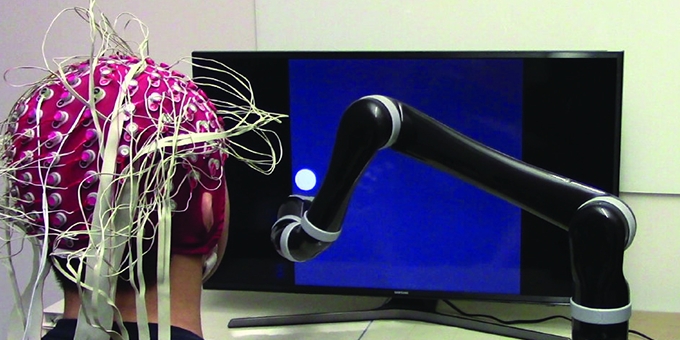Being able to noninvasively control robotic devices using only thoughts will have broad applications, in particular benefiting the lives of paralyzed patients and those with movement disorders.
 First-ever Successful Mind-controlled Robotic Arm Without Brain Implants
First-ever Successful Mind-controlled Robotic Arm Without Brain Implants

Research from | Carnegie Mellon University College of Engineering
A team of researchers from Carnegie Mellon University, in collaboration with the University of Minnesota, has made a breakthrough in the field of noninvasive robotic device control. Using a noninvasive brain-computer interface (BCI), researchers have developed the first-ever successful mind-controlled robotic arm exhibiting the ability to continuously track and follow a computer cursor.
Being able to noninvasively control robotic devices using only thoughts will have broad applications, in particular benefiting the lives of paralyzed patients and those with movement disorders.
BCIs have been shown to achieve good performance for controlling robotic devices using only the signals sensed from brain implants. When robotic devices can be controlled with high precision, they can be used to complete a variety of daily tasks. Until now, however, BCIs successful in controlling robotic arms have used invasive brain implants. These implants require a substantial amount of medical and surgical expertise to correctly install and operate, not to mention cost and potential risks to subjects, and as such, their use has been limited to just a few clinical cases.
A grand challenge in BCI research is to develop less invasive or even totally noninvasive technology that would allow paralyzed patients to control their environment or robotic limbs using their own "thoughts." Such noninvasive BCI technology, if successful, would bring such much needed technology to numerous patients and even potentially to the general population.
However, BCIs that use noninvasive external sensing, rather than brain implants, receive "dirtier" signals, leading to current lower resolution and less precise control. Thus, when using only the brain to control a robotic arm, a noninvasive BCI doesn't stand up to using implanted devices. Despite this, BCI researchers have forged ahead, their eye on the prize of a less- or non-invasive technology that could help patients everywhere on a daily basis.
Bin He, Trustee Professor and Department Head of Biomedical Engineering at Carnegie Mellon University, is achieving that goal, one key discovery at a time.
"There have been major advances in mind controlled robotic devices using brain implants. It's excellent science," says He. "But noninvasive is the ultimate goal. Advances in neural decoding and the practical utility of noninvasive robotic arm control will have major implications on the eventual development of noninvasive neurorobotics."
Using novel sensing and machine learning techniques, He and his lab have been able to access signals deep within the brain, achieving a high resolution of control over a robotic arm. With noninvasive neuroimaging and a novel continuous pursuit paradigm, He is overcoming the noisy EEG signals leading to significantly improve EEG-based neural decoding, and facilitating real-time continuous 2D robotic device control.
Using a noninvasive BCI to control a robotic arm that's tracking a cursor on a computer screen, for the first time ever, He has shown in human subjects that a robotic arm can now follow the cursor continuously. Whereas robotic arms controlled by humans noninvasively had previously followed a moving cursor in jerky, discrete motions—as though the robotic arm was trying to "catch up" to the brain's commands—now, the arm follows the cursor in a smooth, continuous path.
In a paper published in Science Robotics, the team established a new framework that addresses and improves upon the "brain" and "computer" components of BCI by increasing user engagement and training, as well as spatial resolution of noninvasive neural data through EEG source imaging.
The paper, "Noninvasive neuroimaging enhances continuous neural tracking for robotic device control," shows that the team's unique approach to solving this problem not enhanced BCI learning by nearly 60% for traditional center-out tasks, it also enhanced continuous tracking of a computer cursor by over 500%.
The technology also has applications that could help a variety of people, by offering safe, noninvasive "mind control" of devices that can allow people to interact with and control their environments. The technology has, to date, been tested in 68 able-bodied human subjects (up to 10 sessions for each subject), including virtual device control and controlling of a robotic arm for continuous pursuit. The technology is directly applicable to patients, and the team plans to conduct clinical trials in the near future.
"Despite technical challenges using noninvasive signals, we are fully committed to bringing this safe and economic technology to people who can benefit from it," says He. "This work represents an important step in noninvasive brain-computer interfaces, a technology which someday may become a pervasive assistive technology aiding everyone, like smartphones."
This work was supported in part by the National Center for Complementary and Integrative Health, National Institute of Neurological Disorders and Stroke, National Institute of Biomedical Imaging and Bioengineering, and National Institute of Mental Health.
About the College of Engineering
The College of Engineering at Carnegie Mellon University is a top-ranked engineering college that is known for our intentional focus on cross-disciplinary collaboration in research. The College is well-known for working on problems of both scientific and practical importance. Our "maker" culture is ingrained in all that we do, leading to novel approaches and transformative results. Our acclaimed faculty have a focus on innovation management and engineering to yield transformative results that will drive the intellectual and economic vitality of our community, nation and world.
About Carnegie Mellon University
Carnegie Mellon is a private, internationally ranked university with programs in areas ranging from science, technology and business to public policy, the humanities and the arts. More than 13,000 students in the university's seven schools and colleges benefit from a small faculty-to-student ratio and an education characterized by its focus on creating and implementing solutions for real world problems, interdisciplinary collaboration and innovation.
The content & opinions in this article are the author’s and do not necessarily represent the views of RoboticsTomorrow
Featured Product

